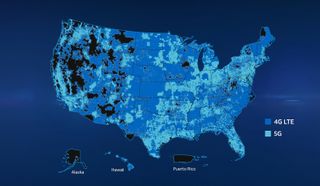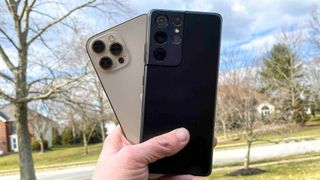AT&T 5G network rollout: Locations, phones, price and more
AT&T's 5G network is expanding — here's where you can find it

The AT&T 5G network has grown in the past year, with testing firms hailing its speeds. But with rivals T-Mobile and Verizon both making splashy 5G moves at the start of 2021, the question is whether AT&T can keep up as the year goes on.
For now, AT&T's focus appears to be on continuing the progress it made throughout 2020 — efforts that included launching a nationwide 5G service to augment its high-speed deployments in three dozen cities and adding more 5G devices to its phone lineup.
- The best 5G phones you can get right now
- 5G vs 4G: Speeds compared
- Speed up your connection with a fast VPN
While AT&T's 5G network currently reaches more than 230 million people in 14,000 cities and towns across the U.S., it still trails T-Mobile, which covers 287 million people with its 5G setup. Verizon also covers 230 million people, even though its nationwide network launched after AT&T's.
In other words, AT&T still has a long way to go in building out 5G coverage. Here's where the network stands as we approach the halfway mark of 2021.
AT&T 5G bands
First off, it’s critical to explain how AT&T splits its 5G service up. There’s the nationwide sub-6GHz service mentioned above, which offers speeds about as fast, if not slightly better than 4G LTE. In spite of AT&T’s “nationwide” banner, this isn’t available everywhere yet, though it’s much more common to find than AT&T’s 5G Plus network, which involves a completely different kind of technology.
5G Plus is AT&T’s name for its millimeter-wave (mmWave) 5G infrastructure. When you hear carriers advertise data speeds in excess of 1 Gbps or downloading entire movies or seasons of TV shows in a minute, this is the kind of 5G they’re referring to. But while millimeter-wave 5G offers exponentially faster speeds than sub-6GHz 5G or 4G LTE, it is exponentially more limited in terms of range, which is why it’s only available in cities or high-traffic indoor spaces.
AT&T 5G cities and coverage map

AT&T’s 5G Plus can only be found in 38 cities in 19 states at the time of this writing. (A 20th state — Colorado — boasts an AT&T 5G Plus installment in its sports arena.) California has the most 5G Plus-supported cities by far, claiming nine of the total 38. You can find a comprehensive list on AT&T’s website.
Sign up to get the BEST of Tom's Guide direct to your inbox.
Get instant access to breaking news, the hottest reviews, great deals and helpful tips.
AT&T is also focusing on getting 5G Plus into arenas, stadiums and convention centers. It currently reaches 20 of those venues, with plans to reach 35 or so by year's end.
AT&T’s long-range 5G service now reaches 230 million Americans, according to the latest figures from the carrier. That's short of what T-Mobile's 5G covers, though both networks are actively growing all the time.
AT&T 5G speeds
AT&T’s 5G infrastructure has made significant strides over the past two years. Initially, the carrier’s 5G Plus service topped out at 400 Mbps. In February 2019, AT&T reported that had improved to a peak throughput of 2 Gbps on its commercial network in Atlanta. That is fast enough to download a 2-hour HD film in 10 seconds.
Unfortunately, we didn’t quite see that kind of performance when we conducted hands-on testing of AT&T’s 5G Plus service in Las Vegas in the summer of 2019. At that time, we recorded peak speeds just shy of 1 Gbps — far better than LTE, of course, but a good sight off the 1.5 Gbps average speed claims the carrier had made at the time. Additionally, it was very difficult to track down a signal in our experience, owing to 5G Plus’ limited range.
AT&T’s standard 5G service, built on sub-6GHz infrastructure, is far easier to locate, in exchange for speeds a fraction as fast. As a point of comparison, T-Mobile's 5G network is built on the same low-band spectrum AT&T uses for its nationwide network (that is, not 5G Plus), and the speeds we've seen there are at best only slightly faster than what we get from LTE.
To be fair, speeds have improved since our initial testing, and AT&T can point to some good recent results from third party network testing. Ookla declared AT&T 5G to be the fastest of the major carriers as of the end of last year, overtaking previous speed champ Verizon. (That may have been the result of Verizon launching its nationwide network and seeing those slower speeds drop its average from the lofty heights achieved by millimeter wave-based 5G.) A report from RootMetrics gives AT&T the nod for the fastest 5G speeds, and while Opensignal thinks T-Mobile has the faster 5G, it noted that AT&T's 5G footprint had grown considerably through the latter half of 2020.
AT&T 5G phones and devices

Most new 2020 flagship phones supported AT&T’s 5G network, though the type of 5G they work with differed on a case-by-case basis. Some handsets, like last year's Samsung Galaxy S20, only offered sub-6GHz connectivity and skip out on millimeter-wave signals. Other phones, like the Galaxy S20 Plus and Galaxy Note 20 Ultra, supported both 5G configurations, for the fastest possible speeds in any condition.
You may have noticed a theme there. Indeed, the vast majority of 5G handsets available last year through AT&T were Samsung devices. But that finally changed with October's iPhone 12 launch.
All four iPhone 12 models work on the full range of AT&T's 5G deployment, across sub-6GHz and mmWave. They are even said to support a new type of 5G infrastructure called C-band, which will provide AT&T users with the sort of mid-band service that offers higher speeds than LTE with a slight hit to coverage, like T-Mobile currently has.
Currently, AT&T offers a pretty compelling range of 5G phones at various price points. Here's an updated list of what's available through AT&T:
- Apple iPhone 12 mini, iPhone 12, iPhone 12 Pro and iPhone 12 Pro Max
- Samsung Galaxy S21, Galaxy S21 Plus and Galaxy S21 Ultra
- Samsung Galaxy Note 20 Ultra and Galaxy Note 20
- Samsung Galaxy A52 5G and Galaxy A32 5G
- Samsung Galaxy A51 5G
- Samsung Galaxy A71 5G
- Samsung Galaxy Z Fold 2
- Samsung Galaxy Z Flip 5G
- Motorola One 5G
- Motorola Razr 5G
- Google Pixel 5
- Google Pixel 4a 5G
- LG K92 5G
- LG Velvet
- LG V60 ThinQ
- LG Wing
- Samsung Galaxy S20 FE, Galaxy S20, Galaxy S20 Plus and Galaxy S20 Ultra
AT&T 5G hotspots
AT&T's first 5G-compatible product was actually the Netgear Nighthawk, a hotspot that could pull in a 5G signal and blast it to your supported devices over Wi-Fi. This device was ultimately discontinued, but now AT&T has replaced that with a successor, called the Netgear Nighthawk 5G Mobile Hotspot Pro. You'll find it among the best mobile hotspots currently available.
The new Nighthawk model, available for $509, supports Wi-Fi 6, meaning you'll lose as little speed as possible from that 5G connection when tethering. It also can service up to 32 devices.
AT&T’s Unlimited Extra and Unlimited Elite plans include hotspot data. But the allotment of hotspot data — 30GB for Elite and 15GB for Extra — runs at 4G speeds.
AT&T 5G plans: What you’ll pay
Here’s the good news: AT&T doesn’t charge extra for 5G service across its three unlimited plans. However, depending on how much you spend and what tier you select, you’ll get more or less full-speed data before AT&T starts throttling you or deprioritizing your service behind that of other users.
The base $65/month Unlimited Starter plan slows your service at any time when AT&T’s network is stressed. That means that although it includes 5G service, the consistency of that service may be in flux from moment to moment. To get the best possible data speeds, you’ll want to at least choose the $75/month Unlimited Extra plan, which allots 50GB of full-speed data, whether you’re on 4G or 5G. The $85/month Unlimited Elite plan doubles that allotment to 100GB before you run the risk of being slowed. See how AT&T's pricing compares in our look at the best unlimited data plan for each wireless carrier.
More customers are now able to access AT&T 5G. In addition to the current unlimited plans, AT&T said in March that it would access to both 5G and 5G Plus to customers with older unlimited plans. Prepaid customers can get 5G coverage through AT&T's $75-a-month unlimited data plan. (Auto-pay enrollment drops that cost down to $60.)
AT&T 5G outlook
More than two years since AT&T launched its first 5G Plus market, the carrier’s 5G deployment has finally reaching a point where many of its customers can take advantage of it. That’s thanks to the launch of the carrier’s nationwide sub-6GHz network as well as the rash of 5G-capable phones that have been dropping throughout the past year.
AT&T customers living in an urban area covered by both the carrier’s regular and 5G Plus services have the unique opportunity to take advantage of both faster speeds and more extensive coverage. And that will only continue in the coming months, as AT&T expands the reach of both types of 5G infrastructure.
AT&T hopes to add 5G Plus coverage in 17 more venues by year's end. After adding 5G Plus to the airport in Tampa, Fla., the carrier wants to bring high-speed 5G to seven additional airports.
As for its nationwide network, AT&T plans to begin rolling out its C-band spectrum by the end of 2021, with more deployment for the year after that. Such a move would complement the existing low-band network, bringing faster mid-band speeds similar to what T-Mobile is doing with its own 5G efforts.
Of course, more than 100 million people already have access to that mid-band coverage in T-Mobile's network. Once again, AT&T finds itself with plenty of 5G ground to make up in the year ahead.
We tried gaming on a 5G smartphone and here's how that went!
Philip Michaels is a Managing Editor at Tom's Guide. He's been covering personal technology since 1999 and was in the building when Steve Jobs showed off the iPhone for the first time. He's been evaluating smartphones since that first iPhone debuted in 2007, and he's been following phone carriers and smartphone plans since 2015. He has strong opinions about Apple, the Oakland Athletics, old movies and proper butchery techniques. Follow him at @PhilipMichaels.
